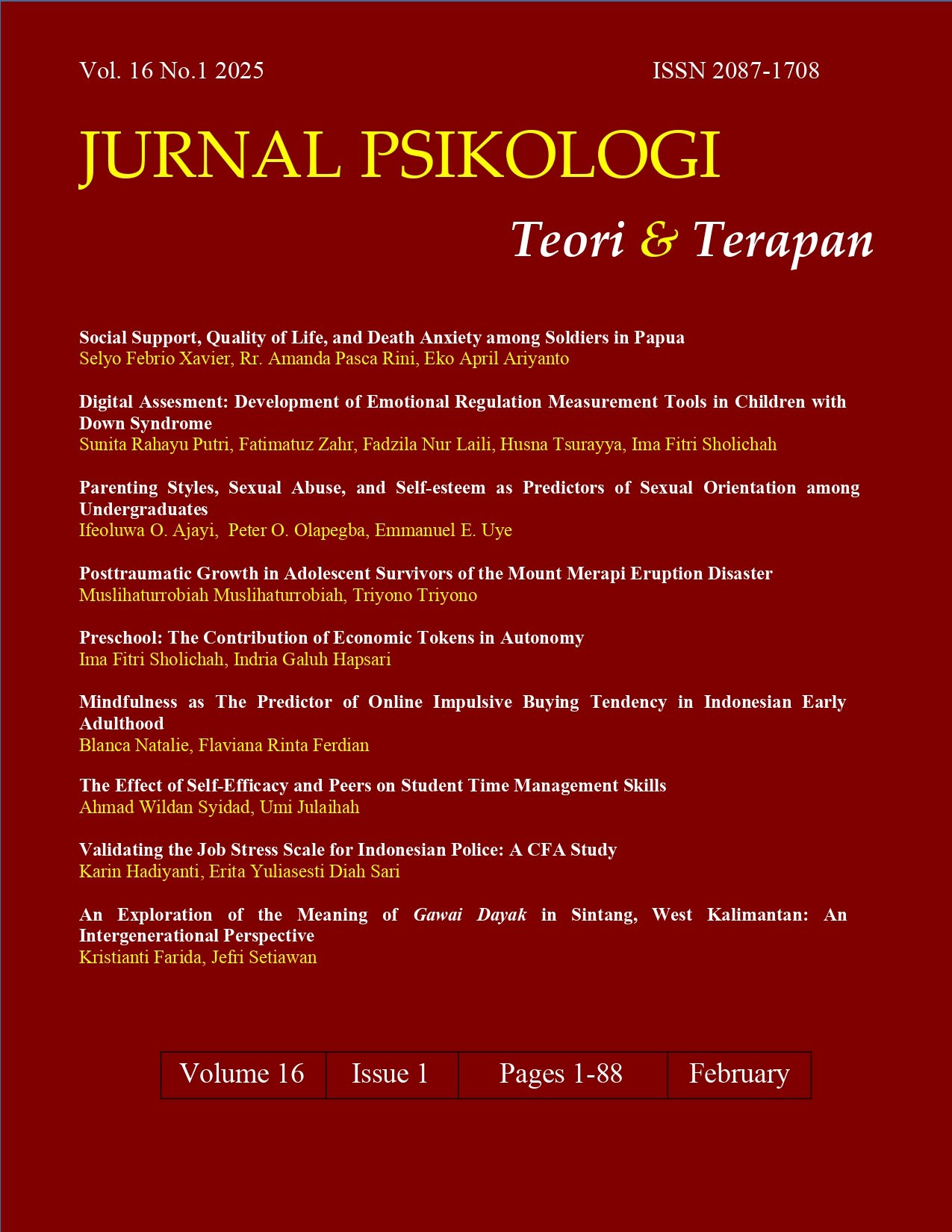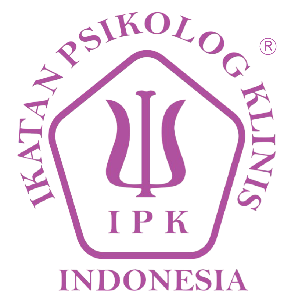Digital Assesment Development of Emotioal Regulation Measurement Tools in Children with Down Syndrome
DOI:
https://doi.org/10.26740/jptt.v16n01.p10-17Keywords:
Digital assesment, down syndrome, DTbERQ, emotion regulationAbstract
Background: Down Syndrome is a genetic disorder that often affects emotional regulation in individuals. Children with down syndrome usually have difficulty understanding and expressing their emotions appropriately. Objective: The purpose of this study was to test the factor structure of the digital version of the ERQ for down syndrome children, which is called the DTbERQ (Digital Technology-based Emotion Regulation Questionnaire). Method: The subjects used in this study were 39 parents or guardians of a child with down syndrome in the city of Gresik-Surabaya. This study involved 2 translators and 2 expert judges. Then a readability test was carried out on 3 subjects before using the DTbERQ on a large scale. The analysis of this study used statistical procedures for validity and reliability tests. Results: The results of this study show that the DTbERQ measuring instrument has proven to be valid and reliable for measuring the emotional regulation of down syndrome children. Conclusion: The DTbERQ measuring instrument can be used well to measure the emotional regulation of children with down syndrome from the perspective of parents or those closest to them.
Keywords: Digital assesment; down syndrome; DTbERQ; emotion regulation.
Abstrak
Latar Belakang: Down Syndrome adalah kelainan genetik yang seringkali mempengaruhi regulasi emosi pada individu. anak-anak dengan down syndrome sering menghadapi kesulitan dalam memahami dan mengekspresikan emosi mereka secara tepat. Tujuan: Tujuan dari penelitian ini yaitu untuk menguji struktur faktor ERQ versi digital untuk setting anak down syndrome yang disebut dengan DTbERQ (Digital Technology based Emotion Regulation Questionnaire). Metode: Subjek yang digunakan dalam penelitian ini adalah sebanyak 39 orang tua atau wali dari anak down syndrome yang ada di kota Gresik-Surabaya. Penelitian ini melibatkan penerjemah 2 orang dan 2 expert judgement. Kemudian dilakukan uji keterbacaan kepada 3 subjek sebelum menggunakan DTbERQ dalam skala yang besar. Analisis penelitian ini menggunakan prosedur statistik uji validitas dan reliabilitas. Hasil: Hasil penelitian ini adalah bahwa alat ukur DTbERQ terbukti valid dan reliabel untuk mengukur regulasi emosi anak down syndrome. Simpulan: Alat ukur DTbERQ dapat digunakan dengan baik untuk mengukur regulasi emosi anak down syndrome melalui sudut pandang orang tua atau orang terdekat.
Kata Kunci: Asesmen digital; down syndrome; DTbERQ; regulasi emosi.
References
Andani Lido, M., Pristiwaluyo, T., & Syamsuddin, H. (2019). Meningkatkan Kemampuan Memakai Pembalut Menggunakan Media Boneka Pada Siswa Down Syndrome di SLB Negeri 2 Kendari. https://eprints.unm.ac.id/33186/1/JURNAL%20MERRY%20ANDANI%20LIDO.pdf
Anuar, N., Cumming, J., & Williams, S. (2016). Emotion Regulation Predicts Imagery Ability. Imagination, Cognition and Personality, 36(3), 254–269. https://doi.org/10.1177/0276236616662200
Azwar, S. (2016). Metode Penelitian. Pustaka Pelajar.
Beaton, D. E., Bombardier, C., Guillemin, F., & Ferraz, M. B. (2000). Guidelines for the Process of Cross-Cultural Adaptation of Self-Report Measures. Spine, 25(24), 3186–3191. https://doi.org/10.1097/00007632-200012150-00014
Bettis, A. H., Burke, T. A., Nesi, J., & Liu, R. T. (2022). Digital Technologies for Emotion-Regulation Assessment and Intervention: A Conceptual Review. In Clinical Psychological Science (Vol. 10, Issue 1, pp. 3–26). SAGE Publications Inc. https://doi.org/10.1177/21677026211011982
Çapik, C., Gözüm, S., & Aksayan, S. (2018). Intercultural Scale Adaptation Stages, Language and Culture Adaptation: Updated Guideline. Florence Nightingale Journal of Nursing. 6(3): 199-210. https://doi.org/10.26650/FNJN397481
Channell, M. M., Conners, F. A., & Barth, J. M. (2014). Emotion Knowledge in Children and Adolescents With Down Syndrome: A New Methodological Approach. American Journal on Intellectual and Developmental Disabilities, 119(5), 405–421. https://doi.org/10.1352/1944-7558-119.5.405
DeVellis, R.F. (2017). Scale Development: Theory and Applications. Sage Publications.
Faught, G. G., Phillips, B. A., & Conners, F. A. (2022). Permissive Parenting Mediates Parental Stress and Child Emotions in Families of Children with Down Syndrome. Journal of Applied Research in Intellectual Disabilities: JARID, 35(6), 1418–1428. https://doi.org/10.1111/jar.13031
Fitri, N. F., & Adelya, B. (2017). Kematangan Emosi Remaja dalam Pengentasan Masalah. Jurnal Penelitian Guru Indonesia-JPGI, 2(2). https://doi.org/http://dx.doi.org/10.29210/02225jpgi0005
Ford, B. Q., & Gross, J. J. (2018). Emotion Regulation: Why Beliefs Matter. Canadian Psychology / Psychologie Canadienne, 59(1), 1–14. https://doi.org/10.1037/cap0000142
García-Villamisar, D., Álvarez-Couto, M., & del Pozo, A. (2019). Executive Functions and Emotion Regulation as Predictors of Internalising Symptoms among Adults with Down Syndrome: A Transdiagnostic Perspective. Journal of Intellectual & Developmental Disability, 45(3), 204–210. https://doi.org/10.3109/13668250.2019.1669004
Giyati, A. N., & Whibowo, C. (2023). Hubungan Antara Self-Compassion dan Regulasi Emosi dengan Stres pada Dewasa Awal. PSIKODIMENSIA: Kajian Ilmiah Psikologi, 22(1), 83–95. https://doi.org/10.24167/psidim.v22i1.5018
Gratz, K. L., & Roemer, L. (2004). Multidimensional Assessment of Emotion Regulation and Dysregulation: Development, Factor Structure, and Initial Validation of the Difficulties in Emotion Regulation Scale. Journal of Psychopathology and Behavioral Assessment, 26(1), 41–54. https://doi.org/10.1023/B:JOBA.0000007455.08539.94
Gross, J. J. (2007). Emotion Regulation: Past, Present, Future. Cognitionand Emotion, 13, 551–573.
Gross, J. J. (2015). The Extended Process Model of Emotion Regulation: Elaborations, Applications, and Future Directions. Psychological Inquiry, 26(1), 130–137. https://doi.org/10.1080/1047840X.2015.989751
Gross, J. J., & John, O. P. (2003). Individual Differences in Two Emotion Regulation Processes: Implications for Affect, Relationships, and Well-Being. Journal of Personality and Social Psychology, 85(2), 348–362. https://doi.org/10.1037/0022-3514.85.2.348
Harjani, H. J. (2020). Interaksi Sosial Anak Nonreguler di SLB Zinnia Jakarta. Journal of Early Childhood Education (JECE), 2(1), 49–61. https://doi.org/10.15408/jece.v2i1.15546
Hayes, A.F., & Coutts, J.J. (2020). Use Omega Rather than Cronbach’s Alpha for Estimating Reliability. But…. Communication Methods and Measures, 14, 1 - 24. https://doi.org/10.1080/19312458.2020.1718629
Jannah, M. (2018). Metodologi Penelitian untuk Psikologi. Surabaya: Unesa University Press.
Khalid, S., Noreen, H., Yaqoob, S., Malik, S., Irum, A., & Iqra. (2023). Emotional Recognition of Children With Down Syndrome and Normally Developing Children: A Comparative Cross-Sectional Study. Pakistan Journal of Health Sciences, 4(3), 198–201. https://doi.org/10.54393/pjhs.v4i03.614
Lazarus, R. S., & Folkman, S. (1984). Stress Appraisal and Coping. Springer Publishing Company, Inc.
Molina, V. M., Oriol, X., & Mendoza, M. C. (2015). Emotional Regulation and Physical Recovery in Young Athletes of Individual and Collective Sport Modalities. RICYDE: Revista Internacional de Ciencias Del Deporte, 11(41), 226–244. https://doi.org/10.5232/ricyde
Nurkhairulnisa, A. I., Chew, K. T., Zainudin, A. A., Lim, P. S., Shafiee, M. N., Kampan, N., Wan Ismail, W. S., Grover, S., & Nur Azurah, A. G. (2018). Management of Menstrual Disorder in Adolescent Girls with Intellectual Disabilities: A Blessing or a Curse? Obstetrics and Gynecology International, 2018. https://doi.org/10.1155/2018/9795681
Paudpedia. (2023). Tiap Tahun 3000 - 5000 Anak Lahir dengan Down Syndrome, Sebanyak 40.928 Sekolah Lakukan Program Inklusi. Https://Paudpedia.Kemdikbud.Go.Id/Kabar-Paud/Berita/Tiap-Tahun-3000-5000-Anak-Lahir-Dengan-down-Syndrome-Sebanyak-40928-Sekolah-Lakukan-Program-Inklusi?Do=MTQ5Ni1mY2Y0YmE4NA==&ix=MTEtYmJkNjQ3YzA=.
Pochon, R., Touchet, C., & Ibernon, L. (2017). Emotion Recognition in Adolescents with Down Syndrome: A Nonverbal Approach. Brain Sciences, 7(6). https://doi.org/10.3390/brainsci7060055
Popianti, R. (2020). Regulasi Emosi Gifted Adolescent (Studi di SMAN 05 Kota Bengkulu). Institut Agama Islam Negeri (IAIN) Bengkulu.
Reaume, C., & Thomassin, K. (2024). Parental Linguistic Content and Distancing Predict Beliefs about Emotion and Child Emotion Regulation. Cognition & Emotion, 1–10. https://doi.org/10.1080/02699931.2024.2362371
Saedpanah, D., Salehi, S., & Moghaddam, L. F. (2016). The Effect of Emotion Regulation Training on Occupational Stress of Critical Care Nurses. Journal of Clinical and Diagnostic Research, 10(12), VC01–VC04. https://doi.org/10.7860/JCDR/2016/23693.9042
Sugiyono. (2016). Metode Penelitian Kuantitatif, Kualitatif, dan R&D. Alfabeta.
Surya, D. J. (2016). Hubungan Kestabilan Emosi Terhadap Stres Akademik pada Remaja di SMAN 4 Jakarta. Universitas Islam Negeri Syarif Hidayatullah.
Downloads
Published
How to Cite
Issue
Section
License
Copyright (c) 2025 Sunita Rahayu Putri, Fatimatuz Zahra, Fadzila Nur Laili, Husna Tsurayya, Ima Fitri Sholichah

This work is licensed under a Creative Commons Attribution 4.0 International License.
Authors who publish in this journal agree to the following terms:
Copyright in any article is held by the author.
The author grants the journal, publication rights with the work simultaneously licensed under a Creative Commons Attribution License that allows others to share the work with an acknowledgment of the work's authorship and initial publication in this journal.
Authors may enter into separate, additional contractual arrangements for the non-exclusive distribution of the journal's published version of the work (e.g., posting it to an institutional repository or publishing it in a book), with an acknowledgment of its initial publication in this journal.
Authors are permitted and encouraged to post their work online (e.g., in an institutional repository or on their website) prior to and during the submission process, as this can lead to productive exchanges, as well as earlier and greater citation of published work.
 Abstract views: 569
,
Abstract views: 569
, PDF Downloads: 540
PDF Downloads: 540


















